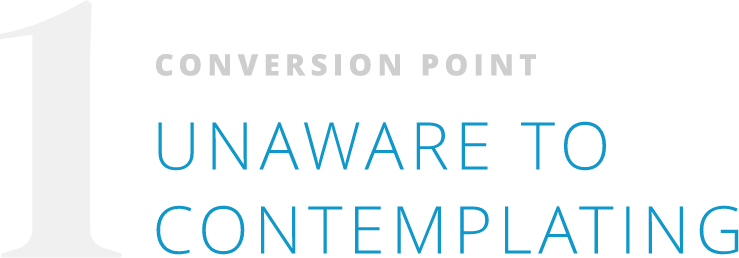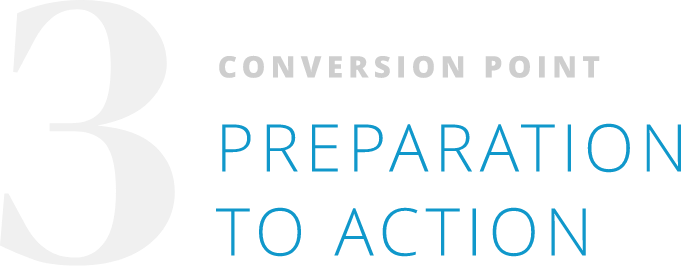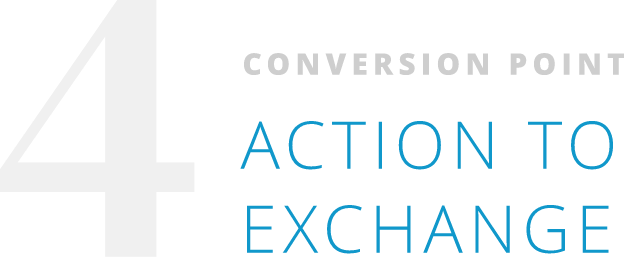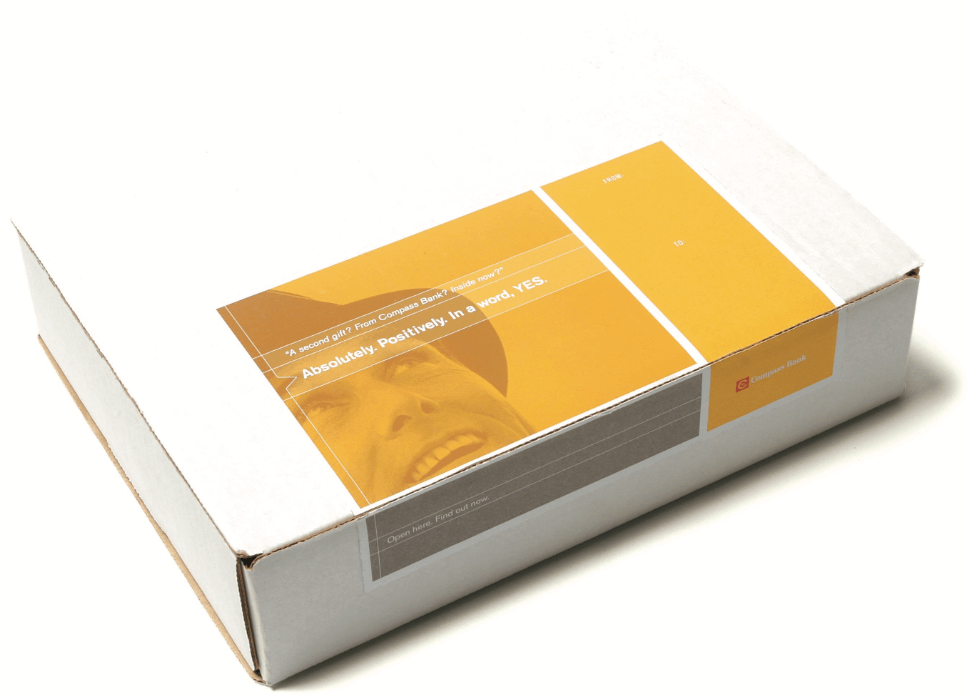
Selling a new client is a process of behavior change. You want them to quit buying from your competitor and start buying from you, right? This is particularly a challenge when you face a long, complex sales process with multiple decision-makers.
We’ve taken the research of three renowned scientists (Prochaska, Norcross and DiClementa) into behavior change and applied their model to the complex sales process our clients must navigate.
Here’s the basic principle, and some of this will sound familiar. There are six stages in the decision-making process and at each stage, people need specific information to move forward toward a decision. Missing information, the wrong information or the right information presented at the wrong time creates barriers that prevent people from moving forward.
“The CDJ. Right. Heard that before.”
That is not what made the work of our renowned scientists famous. No, it was the nine processes they identified that help people move through specific barriers in the decision process. Those nine processes are the key.
At this point, don’t think tools. We’re not talking about ads or websites — we’re talking about the ideas behind those tools.


Make the problem, and your company, known
Consider a prospect who is Stage 1: Unaware. What does that even mean? It might mean they’ve never heard of your company. It might mean they know who you are but have no idea that you can help them solve a problem. Or it might mean they aren’t even aware that they have a problem. It is the role of marketing to make prospects aware and help them move to Stage 2: Contemplating.
The first two of our nine processes are effective in this earliest stage of the decision journey:
Process One: Consciousness raising
 Creating Awareness. It is the process most people are familiar with, the problem that most agencies are set up to solve. Think advertising. Think public relations.
Creating Awareness. It is the process most people are familiar with, the problem that most agencies are set up to solve. Think advertising. Think public relations.
First, you have to be seen. You have to capture the prospect’s attention. That’s one of the hardest parts of the entire decision process.
Your work has to frame the problem in a way that helps your prospect see the true nature of the problem. They have to see their own pain. They need context, so they see your company with fresh eyes.
Process Two: Social Liberation/External forces
This process is trickier. An example helps.
We have a client who manufactures a system that tests the fit of the masks that firemen and other first responders wear. In the US, there have been standards for years that the masks have to meet. That’s not been true in Europe.
Our client, though, is working with the European Union to craft the first regulations that will require fit testing throughout the EU. They are literally helping write the regulations that will raise awareness of the problem and the solution our client provides.
It’s less about being witty or clever and more about educating. And your work should make finding and understanding the information a prospect needs as easy as possible.

Making plans
In the Contemplation stage, your prospect is aware of the problem and thinking about making a change. So what will help them begin preparing to make a decision, meaning they intend to buy in the next 6 months?
Process Three: Emotional Arousal
Again, we have a couple of processes. The first is Emotional Arousal.
Here we’re trying to get people excited about your product. And yes, people can get excited about even the most technical products. If a prospect can imagine themselves using your product, they are far more likely to actually use it.
That’s our goal at this stage. Show me what success looks like. Show me someone with problems like mine who has benefited from your service or product. At this point, it’s not about you, it’s about your prospect. We’re trying to get them emotionally invested in the change. This rule of communication is broken more than any other.
Process Four: Rational Reevaluation
The second process that works at this conversion point is kind of the opposite: Rational Reevaluation. Think Data. Think ROI. How-to’s. Product reviews.
In your writing and your design, you need to emphasize the facts. Show don’t tell — prove the benefits you claim. The tools at this point are often designed to help people who’ve already made an emotional decision rationalize their choice, maybe to themselves. Maybe to their boss.


Make it easy
The third conversion point is a delicate time in the process. In Stage 3: Preparation, your prospect is getting ready to buy. They are making a plan. They are defining their needs. They are beginning to talk about the future. Not “should they buy” but more “how is this going to work”.
From our perspective, we’re trying to provide safety and reassurance. This is especially true if you are not the big dominant brand. If you are the underdog — if you are seen as risky — this is a place where a lot of sales are lost.
At the third conversion point, while much of the attention shifts to selling behaviors, marketing still plays a role.
We want to make the final buying decision seem as easy and comfortable as it can be. Emotional Arousal and Rational Reevaluation messages still work at this stage, but we also have one other process to help the prospect choose to move forward.
Process Five: Private then public commitment
These are personal reassurance tools to create safety. It might be a small engagement or test project— they are still buying, but in a small way with no long term commitment.
It might be deep customer testimonials, far more detailed than early-stage soundbites. It looks more like a look behind the curtain. Introduce long-time users of your product or service and let them be your voice.
Show don’t tell. Show them the process of buying. Show them what implementation looks like. Show them how customer support works. Make it easy.

The check clears
At this point, your prospect is really getting into the specifics of working with you. But — and this is a big but — their behavior still hasn’t changed. It happens all the time that you get right up to the point of closing and the prospect ghosts you. Every experienced sales person has felt this and few things are more frustrating.
The solution to this challenge is driven by sales behaviors, but marketing isn’t out of the picture.
Process Six: Helping Relationships
Your best customers, your advocates, can play a role here. Maybe it’s a reference call or an in-depth testimonial about how you serve that client. You want your prospect to see behind the curtain, to hear from someone with deep experience working with your company or using your product.
Process Seven: Positive Substitution/Countering
 A change is in process here. Maybe it looks like a pilot project — have you written a white paper on a small-scale pilot project you’ve done for other clients? Package that, emphasizing in design and writing how a toe-in-the water turned into a full-client relationship. Don’t overelaborate or exaggerate. Keep it to the point. Simple is better, though not easier.
A change is in process here. Maybe it looks like a pilot project — have you written a white paper on a small-scale pilot project you’ve done for other clients? Package that, emphasizing in design and writing how a toe-in-the water turned into a full-client relationship. Don’t overelaborate or exaggerate. Keep it to the point. Simple is better, though not easier.
Process Eight: Environmental Control
This is often about getting your prospect out of their own environment. Maybe it’s an off-site retreat or working meals to talk about implementation and what’s going to happen after the sale.
Process Nine: Rewards for Positive Behavior
Classic sales tactics. Maybe it’s a book or tickets to a show or a celebration dinner. Something nominal that expresses your appreciation. Good design and good writing can take a simple gift and package it into an experience that the prospect won’t soon forget.
Our Work
-
 The Washington Center
Rapid growth comes from sales and marketing in alignment with the prospect.
The Washington Center
Rapid growth comes from sales and marketing in alignment with the prospect.
-
 BBVA Compass Smart Pursuits
“Yes, the results were good. As usual, you did outstanding work for us.”
BBVA Compass Smart Pursuits
“Yes, the results were good. As usual, you did outstanding work for us.”
-
 OHD Demand Generation
Monthly submissions jumped from 19 to 80+
OHD Demand Generation
Monthly submissions jumped from 19 to 80+



